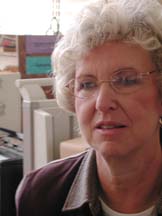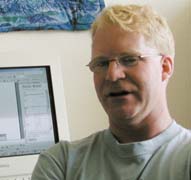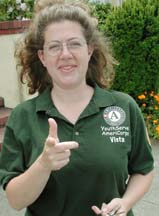|
by ANDREW EDWARDS and KEITH EASTHOUSE IT WAS A BEAUTIFUL SUN-DRENCHED DAY, THE SATURDAY of Arcata's annual Oyster Festival. The plaza was ringed with blue vendor booths, the lawns packed with revelers slurping shellfish, quaffing local brews, taking in the show. Tucked away from the crowd, on the corner of G and Eighth streets, another party was taking place. Young members of two local AmeriCorps programs were on the scene painting faces, making multi-colored prints of fish, entertaining. Part of the reason they were there was simply to get the word out about the two programs, the AmeriCorps Watershed Stewards Program and YouthServe AmeriCorps. But they were also encouraging anyone who would listen to contact their elected representatives in Congress. Why? Because they knew something that had not yet been made public: Funding for AmeriCorps, one of the nation's most prominent public service agencies, was being seriously slashed. Two days later, back in Washington, D.C., the official announcement was made -- AmeriCorps was cutting the largest category of its workers by more than 80 percent. AmeriCorps officials blamed congressional cuts to its budget, but also acknowledged an internal accounting problem. AmeriCorps director Rosie Mauk said so-called "state competitive programs" would be affected -- those that apply for AmeriCorps funding through their state governments. While that represents only one-fourth of AmeriCorps' programs nationwide, it is still a major step downward: The number of volunteers working in state competitive programs is expected to fall from 16,000 to 3,000. And that may just be the beginning, as the financially troubled agency will decide the future of the rest of its programs later this summer. The way it looks now, AmeriCorps -- which provides federal grants to more than 2,000 nonprofit, public and religious groups across the country -- will only be able to fill about half of the 50,000 volunteer slots it had been planning on filling in the current year. One bright spot emerged last week as senators from both parties introduced legislation to shore up the agency's budget. But at this point it appears such 11th-hour efforts are coming too late for some AmeriCorps programs on the North Coast. The Redwood Community Action Agency's Straight Up AmeriCorps program, whose 55 members provide a multitude of services to local schools, youth recreation services and family shelters in Humboldt County, has lost all of its federal funding and is closing up shop in August. Meantime, the Watershed Stewards Program, which turned out 54 members this year and has played a major role in salmon restoration and education efforts, is also on the brink of disappearing. Only YouthServe, which receives its funding in a slightly different way, has been spared the budget axe. But that could change soon. Site Supervisor Scotty Appleford said the program, which has 40 members based in McKinleyville and Crescent City who provide counseling and other assistance to alternative school teenagers, should have a better idea of its future by the end of this month. When asked, Appleford said he had no way of telling what the news would be. But he acknowledged that he wasn't optimistic. "The only indication right now is the programs around us and what's happened with them, which isn't very good." Boom to bust This was supposed to be a good year for AmeriCorps. In his State of Union Address in January, President Bush called for a new spirit of national service, and pledged to do his best to expand government programs of national service like AmeriCorps. In numerous speeches over the past several months, Bush -- pushing the theme of "compassionate conservatism" -- has made a point of introducing AmeriCorps workers and has promised his audiences that the program would be increased by 50 percent. It seemed to be more than mere rhetoric, as the president's budget for the upcoming fiscal year sets out as a goal increasing AmeriCorps' ranks from 50,000 to 75,000 people. The AmeriCorps community reacted with understandable exuberance, and many site directors across the country geared up their recruitment efforts. Skeptics, however, pointed out that the president's budget request for 2004 was actually a budget cut: a $40 million reduction in AmeriCorps' grants, from $364 million in the current fiscal year to $324 million in the upcoming one, which begins Oct. 1. But the real problem was the 2003 spending bill, in which the Republican Congress appropriated only $175 million for AmeriCorps grants -- barely half of the money the agency was supposed to receive. Not only that, Congress capped the number of AmeriCorps volunteers at 50,000 and didn't respond when Bush called in March for the cap's removal. One of Congress' gripes with AmeriCorps has to do with a dispute over the way in which the agency sets aside money to finance future education benefits for AmeriCorps volunteers. To understand what that's all about, it is first necessary to learn a little more about AmeriCorps. A domestic Peace Corps To a large extent, AmeriCorps is a domestic version of the Peace Corps, the Kennedy administration's program which harnessed the energy and idealism of recent college graduates to do relief work worldwide. In 1993 the Clinton administration unveiled plans for the AmeriCorps program. Volunteers would serve for a year in communities across the nation, receiving a $9,300 yearly allowance that barely amounted to minimum wage (most AmeriCorps member receive food stamps). Then, when their service was complete, they would get a one-time "education award" of $4,750 to further their education or pay off pesky student loans.
"We get this great pool of folks," Flosi said, sitting in his Fortuna office last week. "The costs are really minor compared to paying salary, workers comp, insurance and all those other things [for regular staff]." One way AmeriCorps works is that state agencies like Fish and Game put up a portion of a member's stipend, with the rest covered by the federal government. That has enabled Flosi to get highly motivated, entry-level workers for about $2.35 an hour. "It's been a terrific program," he said. Others delighted to have cheap, intelligent help felt the same way, and for several years AmeriCorps was a Clinton administration success story. Troubled waters But by the late 1990s, problems began to crop up. In particular, Republican lawmakers with a political bias against AmeriCorps started to take aim at the trust that Congress had established to fund the education awards guaranteed to each AmeriCorps member. In October 1999 Congress removed $80 million from the trust, ostensibly because the size of the trust had grown excessively large compared to how much was being used each year. The following fall another $30 million was slashed. Then came the terrorist attacks of Sept. 11, 2001, which triggered a surge of volunteerism -- in AmeriCorps and in other similar organizations. By late last year it became clear that the organization had signed up more recruits than it could afford. The trust, which a few years before had seemed needlessly large, was now too small to pay recruits the education grants and living expenses that they are guaranteed for one year of service. But there was another problem. The Corporation for National and Community Service, the public-private partnership that administers AmeriCorps and two other public service agencies, was running into legal trouble. It was taking the interest earned on the national savings bonds that the trust is invested in and using it to finance further education awards. It was not a case of malfeasance -- no one was trying to illegally enrich themselves -- but it was a violation of federal law. "The law says all interest must be returned to the general fund," said Bob Wilson, local director of Straight Up AmeriCorps. So, when the national corporation was audited recently, it was determined that the corporation owed the government's general fund around $100 million. The debt was forgiven, but the incident sent the corporation into a financial freefall from which it has yet to recover. Straight down The impact of all of this on AmeriCorps programs here on the North Coast is, in a word, devastating. It is likely that out of 150 AmeriCorps positions in Humboldt County, only 20 quarter-time positions -- the equivalent of five full-time positions, will survive. These AmeriCorps participants take part in programs that affect people every day. Straight Up AmeriCorps members work in classrooms around the county, doing the things schools wouldn't otherwise have the money to do: mentoring, tutoring, teen pregnancy prevention, after-school programs. Across the hallway from the principal's office at Eureka High, a room labeled "Special Projects" is the nerve center for the 13 AmeriCorps members on campus. Last week some of them gathered around a round table with a journalist to discuss the impact their program had had on students and on themselves. Many said they had planned to return for a second final year of service, no longer an option now.
Some said they felt lucky that they had been able to participate in the program, which includes training in drug education, child development, grant writing and gang prevention, among other things. "Our resumes have just blossomed," said Luke Johnson. [photo at right] Heads nodded in agreement. For many, AmeriCorps seems to have changed their lives. Take Eduardo Urbina, a Humboldt State University graduate. He said the program enabled him to better focus his career goals: He now knows he wants to be a school counselor. Others spoke of a desire to work in education; for them, AmeriCorps appears to be a jumping off point for a lifetime of service. It's a common story from AmeriCorps members. They come for the college money and end up staying because they fall in love with their projects. Marge Crichton, special projects director for Eureka High [photo below left] , had nothing but good things to say about her AmeriCorps members. They are "incredibly talented people, willing to serve," she said.
"The kids, I just don't know what to tell them," he said. "They're already holding onto the edge of the cracks and seeping through as it is." The members spoke of success stories, kids whose grades had improved, who had succeeded at graduating, who had gotten a job, or just found a place to live. Others, they said, had opened up and blossomed confidently under their mentorship. Bottom line: the Straight Up AmeriCorps program is gone, for at least a year, likely forever. It took 10 years to build, and it won't be easy to put back together. Crichton pointed out that grants that would have supplied the matching funds for next year's program will fall by the wayside and may be hard to get again. Helping salmon The program that Flosi founded, along with fellow fish and game employee Scott Downie and Michelle Rose of the California Conservation Corps, developed into the Watersheds Stewards Project, or WSP for short. It employs just over 50 AmeriCorps participants in sites all over the North Coast, from the Bay Area up to Oregon. They have served as the grunt labor, the recruitment pool for most of the environmental restoration work that has taken place on the North Coast over the past 10 years. Flosi's eight WSP members (40 percent of his workforce) survey about 150 miles of streams each year, gathering data that would be simply too expensive to get otherwise. He mentioned the North Coast Watershed Assessments Project, a now-defunct state program that took a comprehensive approach to watershed analysis. Several watersheds were evaluated before the program was shut down due to the state budget crisis. "Without those crews there is no way those assessments could have been done," Flosi said. The assessments provide a scientific basis for deciding which restoration projects fish and game should undertake. Prior to the creation of the WSP, such data was simply unavailable; projects were evaluated on "intuition," Flosi said. Sitting at his desk recently, Flosi looked like a worried man. The mammoth state and federal budget crunches are hitting his department from all sides; the loss of the WSP just adds injury to insult. In addition to losing their "troops," as Flosi put it, most of the resource professionals, both governmental and private, are losing their pool of recruiting talent.
One of WSP's leaders, Gina Bauer, told of a recent Salmonid Restoration Council meeting, a convention of restoration professionals. When a speaker asked former members of WSP to stand up, three-quarters of the room of 400 rose. One such AmeriCorps alum is Allan Renger, a fisheries biologist in Flosi's office. [photo at right] He had been looking for a job in the resource field, but all the entry-level jobs required years of experience. So when he came across an AmeriCorps booth at a job fair, he saw an opportunity. "I went to work for AmeriCorps at this Department of Fish and Game office and it turned out I really like the work," Renger said. He served his term, and when a position came available he was hired, largely because he already knew everybody in the office. Too late?
Rep. Mike Thompson said there was a good chance that some supplemental funding will be provided when Congress passes another spending bill in October, but he acknowledged that it was a little late in the game for many AmeriCorps programs, including those on the North Coast. "It's hard to put the toothpaste back in the tube," Thompson said. "The question is whether the damage has already been done. We've got all these programs that are suspended, and we've got all these kids that aren't able to do the good work they've volunteered to do."
Staff writer Bob Doran contributed to this report.
IN THE NEWS | GARDEN | GOOD NEWS | PUBLISHER | CALENDAR
Comments? © Copyright 2003, North Coast Journal, Inc. |

![Dashed Dreams: The Demise of AmeriCorps [photo of group on the steps of high school]](cover0626-photohed.jpg)
 Immediately,
people like Gary Flosi from the California Department of Fish
and Game [photo at left]
saw
the potential. He could get highly motivated college grads, looking
for experience and a little spending money, for next to nothing.
He jumped at the opportunity, using AmeriCorps workers for the
past nine years.
Immediately,
people like Gary Flosi from the California Department of Fish
and Game [photo at left]
saw
the potential. He could get highly motivated college grads, looking
for experience and a little spending money, for next to nothing.
He jumped at the opportunity, using AmeriCorps workers for the
past nine years. The
general feeling expressed was one of shock: changed plans, aborted
projects, uncertainty.
The
general feeling expressed was one of shock: changed plans, aborted
projects, uncertainty. As
Johnson pointed out, the real losers are the kids, some of whom
have already led disadvantaged lives.
As
Johnson pointed out, the real losers are the kids, some of whom
have already led disadvantaged lives. "[In
WSP] we are training the next generation of resource professionals,"
Flosi said.
"[In
WSP] we are training the next generation of resource professionals,"
Flosi said. While
the picture certainly looks bleak, not everyone is in despair.
"I'm eternally optimistic," said Tara Drobnick, a member
of the AmeriCorps VISTA program that helps administer the YouthServe
in McKinleyville. "You have to hope, you have to hope absolutely.
We have to keep moving forward. We're still being helpful."
While
the picture certainly looks bleak, not everyone is in despair.
"I'm eternally optimistic," said Tara Drobnick, a member
of the AmeriCorps VISTA program that helps administer the YouthServe
in McKinleyville. "You have to hope, you have to hope absolutely.
We have to keep moving forward. We're still being helpful."